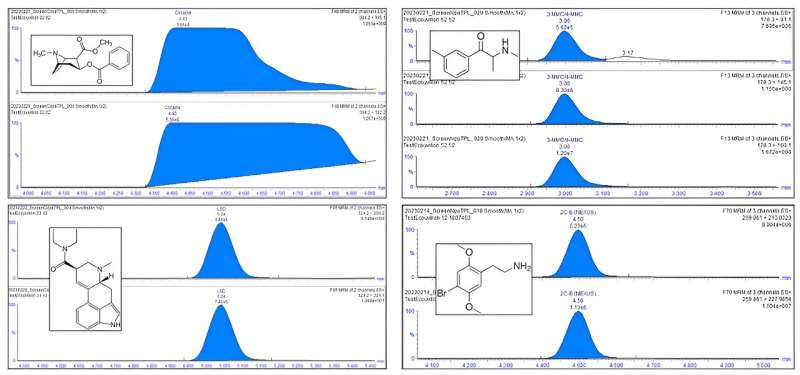This article has been reviewed according to Science X's editorial process and policies. Editors have highlighted the following attributes while ensuring the content's credibility:
fact-checked
proofread
Smartphone swabs provide convenient toxicology testing

A simple and convenient method to collect drug use data from the surface of a smartphone has been revealed for the first time in a new study published in Clinical Chemistry and Laboratory Medicine (CCLM). By helping clinicians understand which drugs people are taking in certain contexts, the research could protect public health and improve the treatment of patients suspected of overdosing.
Understanding the most common drugs in a particular area, who uses them, when they use them and in what contexts can help inform life-saving treatment decisions, but given the illegal nature of many recreational drugs, such data are not always easy to obtain. Researchers can employ indirect techniques, such as analyzing wastewater or conduct anonymous surveys with drug users, pairing the results with toxicological measurements such as blood or urine samples. However, such approaches can be inaccurate and too invasive for routine use.
Dr. Théo Willeman of Grenoble Alpes University Hospital, France and colleagues explored whether one of our most handled objects—the smartphone—could be a more convenient way to track drug use. Fingerprints on a phone's surface contain sweat and sebum that can reveal the presence of drugs, and the surface itself can retain traces of any drugs consumed directly from it.
The researchers invited drug users at techno and trance music events in France to anonymously complete a questionnaire about their drug use, and then dry swabbed the surface of their smartphones. The swabs were later analyzed using liquid chromatography to detect drugs.
The researchers collected and analyzed 122 swabs and successfully identified a variety of drugs. The three most common were MDMA, cocaine and THC, but the researchers also found ketamine, LSD, methamphetamine, CBD, heroin and mescaline. The results confirm that smartphones can successfully provide a convenient and non-invasive way to assess drug use.
The study has some limitations. For instance, the stability of drug molecules on a smartphone surface is not known, and this could influence the results if substances degrade quickly or slowly. The method is also limited by the possibility that several people may have handled the smartphone or it could be contaminated by drug traces in the environment. However, the study is intended as a proof-of-concept, and further research can cast light on these unknowns and further validate the technique.
"The opioid crisis in the US was recognized as a public health emergency by the US President in 2016," said Dr. Willeman. "As a result, developing new tools to perform toxico-epidemiology studies is crucial, and identifying which substances are consumed in a particular area may help medical teams managing potential intoxications."
More information: Théo Willeman et al, Smartphone swabs as an emerging tool for toxicology testing: a proof-of-concept study in a nightclub, Clinical Chemistry and Laboratory Medicine (CCLM) (2024). DOI: 10.1515/cclm-2024-0242




















